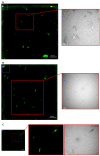Tracking Bacterial Nanocellulose in Animal Tissues by Fluorescence Microscopy
- PMID: 35957036
- PMCID: PMC9370207
- DOI: 10.3390/nano12152605
Tracking Bacterial Nanocellulose in Animal Tissues by Fluorescence Microscopy
Abstract
The potential of nanomaterials in food technology is nowadays well-established. However, their commercial use requires a careful risk assessment, in particular concerning the fate of nanomaterials in the human body. Bacterial nanocellulose (BNC), a nanofibrillar polysaccharide, has been used as a food product for many years in Asia. However, given its nano-character, several toxicological studies must be performed, according to the European Food Safety Agency's guidance. Those should especially answer the question of whether nanoparticulate cellulose is absorbed in the gastrointestinal tract. This raises the need to develop a screening technique capable of detecting isolated nanosized particles in biological tissues. Herein, the potential of a cellulose-binding module fused to a green fluorescent protein (GFP-CBM) to detect single bacterial cellulose nanocrystals (BCNC) obtained by acid hydrolysis was assessed. Adsorption studies were performed to characterize the interaction of GFP-CBM with BNC and BCNC. Correlative electron light microscopy was used to demonstrate that isolated BCNC may be detected by fluorescence microscopy. The uptake of BCNC by macrophages was also assessed. Finally, an exploratory 21-day repeated-dose study was performed, wherein Wistar rats were fed daily with BNC. The presence of BNC or BCNC throughout the GIT was observed only in the intestinal lumen, suggesting that cellulose particles were not absorbed. While a more comprehensive toxicological study is necessary, these results strengthen the idea that BNC can be considered a safe food additive.
Keywords: absorption; bacterial cellulose nanocrystals; bacterial nanocellulose; cellulose binding module; fluorescence microscopy; food additive; gastrointestinal tract.
Conflict of interest statement
The authors declare no conflict of interest.
Figures









Similar articles
-
Bacterial cellulose nanocrystal as drug delivery system for overcoming the biological barrier of cyano-phycocyanin: a biomedical application of microbial product.Bioengineered. 2023 Dec;14(1):2252226. doi: 10.1080/21655979.2023.2252226. Bioengineered. 2023. PMID: 37646576 Free PMC article.
-
Bacterial cellulose nanocrystals exhibiting high thermal stability and their polymer nanocomposites.Int J Biol Macromol. 2011 Jan 1;48(1):50-7. doi: 10.1016/j.ijbiomac.2010.09.013. Epub 2010 Oct 23. Int J Biol Macromol. 2011. PMID: 20920524
-
Toxicological Characteristics of Bacterial Nanocellulose in an In Vivo Experiment-Part 1: The Systemic Effects.Nanomaterials (Basel). 2024 Apr 26;14(9):768. doi: 10.3390/nano14090768. Nanomaterials (Basel). 2024. PMID: 38727362 Free PMC article.
-
The role of genetic manipulation and in situ modifications on production of bacterial nanocellulose: A review.Int J Biol Macromol. 2021 Jul 31;183:635-650. doi: 10.1016/j.ijbiomac.2021.04.173. Epub 2021 May 3. Int J Biol Macromol. 2021. PMID: 33957199 Review.
-
[Nanocellulose in the food industry and medicine: structure, production and application].Vopr Pitan. 2022;91(3):6-20. doi: 10.33029/0042-8833-2022-91-3-6-20. Epub 2022 May 4. Vopr Pitan. 2022. PMID: 35853186 Review. Russian.
Cited by
-
Toxicological Characteristics of Bacterial Nanocellulose in an In Vivo Experiment-Part 2: Immunological Endpoints, Influence on the Intestinal Barrier and Microbiome.Nanomaterials (Basel). 2024 Oct 19;14(20):1678. doi: 10.3390/nano14201678. Nanomaterials (Basel). 2024. PMID: 39453014 Free PMC article.
-
Synthesis, Applications and Biological Impact of Nanocellulose.Nanomaterials (Basel). 2022 Sep 14;12(18):3188. doi: 10.3390/nano12183188. Nanomaterials (Basel). 2022. PMID: 36144981 Free PMC article.
References
-
- Serpa A., Velásquez-Cock J., Gañán P., Castro C., Vélez L., Zuluaga R. Vegetable nanocellulose in food science: A review. Food Hydrocoll. 2016;57:178–186. doi: 10.1016/j.foodhyd.2016.01.023. - DOI
Grants and funding
LinkOut - more resources
Full Text Sources

